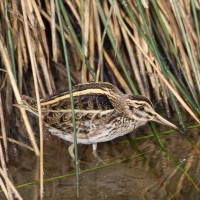Opis
The area around Horn kyrka is a quite good site for geese with hundreds of ges zbozowa, gęgawa, and bernikla kanadyjska found most years. Often with lesser amounts of gęś białoczelna, gęś tundrowa, gęś krótkodzioba, and bernikla białolica interspersed. bernikla obrożna has been seen. Most geese are found by Rien (marked with a star on the map) in late Febuary and March.
During the spring Riens water overflow and large amounts of open water form. When this happens large amounts of krzyżówka (at most 200), and cyraneczka (at most 150) rest in the area. Among these ducks you can observe smaller amounts of świstun, krakwa, świstun, rożeniec (uncommon), Płaskonos (uncommon), and cyranka (rare). Sometimes also some diving ducks. But since water levels vary each spring the amount and variation of ducks at Rien vary accordingly. The wetland at Hornebergs holds permanent water, and usually some dabbling ducks, but not in the same amount. Horn Marsh along with its ponds is also quite good for small amounts of different dabbling ducks.
Diving ducks are most usually found in Åsunden with nurogęś, czernica, gągoł being common, while szlachar and bielaczek are uncommon. At Trossbonäs rare diving ducks like markaczka, and uhla can be found with luck in April. Even edredon and ogorzałka have been seen there.
In spring if Rien has water in late April waders rest there. łęczak, samotnik (at most 23), czajka, and kszyk (at most 100). On the fields siewka złota, at Åsunden brodziec piskliwy sing, and in the forests słonka can be found. During heavy autumn rain Rien can gain enough water for waders such as kwokacz, batalion, biegus zmienny, kulik wielki, sieweczka obrożna, and biegus krzywodzioby. The fields around Bränna and Västa eneby are pretty good areas for bekasik in November.
Among predatory birds pustułka (zwyczajna), myszołów, Trzmielojad, myszołów włochaty, bielik, krogulec, jastrząb, rybołów, kobuz and błotniak zbożowy are all common. orzeł przedni, drzemlik, sokół wędrowny, and kania czarna are all rare but seen some years. The best places for them are Bränna, Rien, and Åshorva.
Large amounts of passerine birds move along the fields around Horn, therefore large amounts of makolągwa, świergotek łąkowy, pliszka żółta and other common meadows birds are found along with other rare passerine birds like podróżniczek, drozd obrożny, poświerka (very rare), śnieguła, and rzepołuch. The best places for these are Bränna and Rien.
The wetland around Rien and Hornsberg have large amounts of reed and trees which make them excellent places for nightactive birds. All the common bird are found some years with derkacz, przepiórka, zaroślówka, strumieniówka, kropiatka, and świerszczak. Even zielonka has been found.
Szczegóły
Dostęp
Horn is located on the southern shores of lake Åsunden. No good parking spots can be found for most of these places but it is often possible to park alongside the road. The area is best explored with bike or car and perhaps not best suited to tourists because there are few facilities for visitors.





